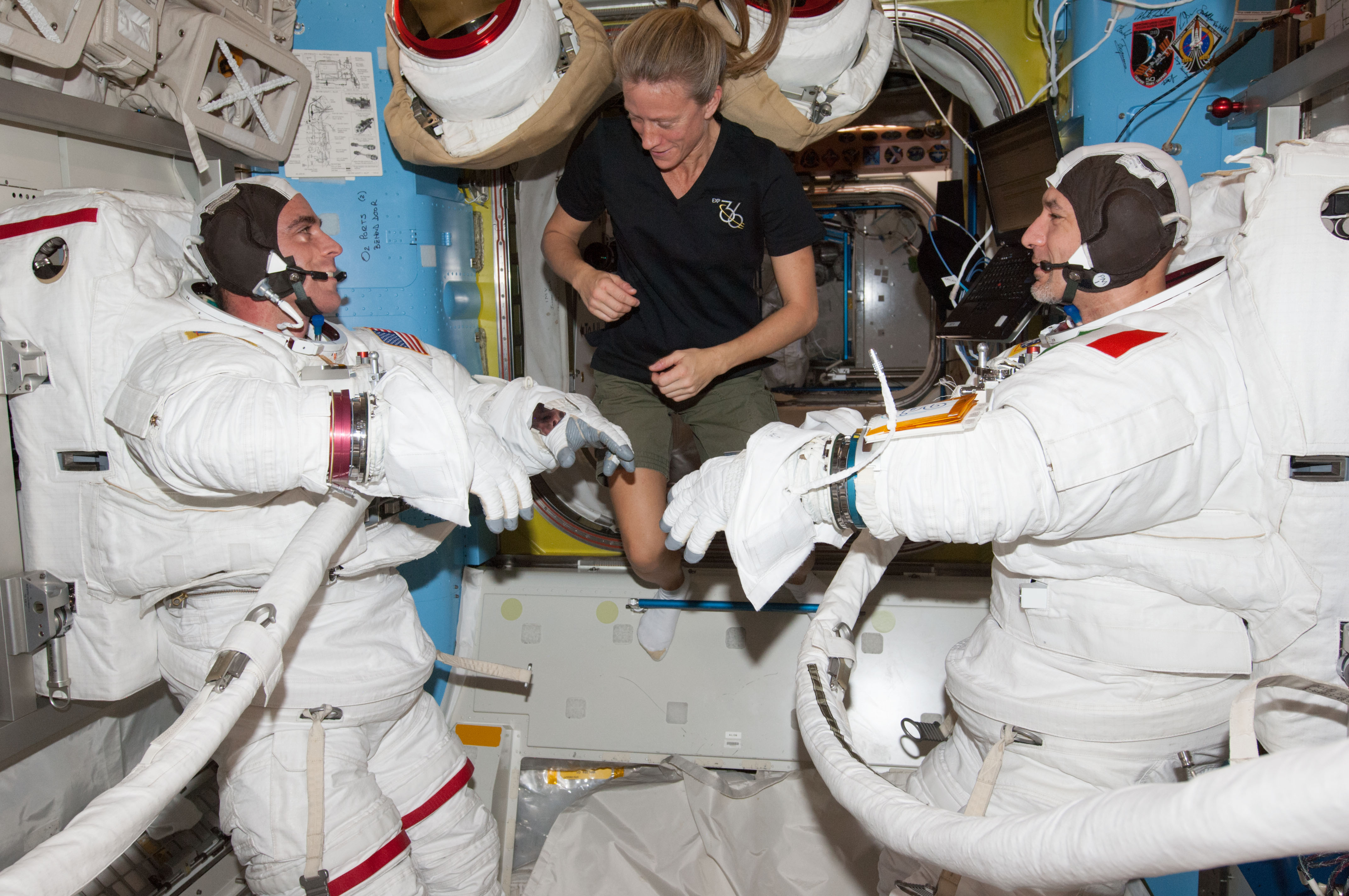
Two astronauts, including Italy’s first spacewalker, will venture outside the International Space Station at 8:10 a.m. EDT Tuesday, 9 July on the first EVA from the U.S. Operating Segment (USOS) during the current Expedition 36. Chris Cassidy (EV1), a veteran of four previous spacewalks, and first-timer Luca Parmitano (EV2) will spend 6.5 hours outside the orbital outpost replacing a failed component of one of two space-to-ground antennas, installing two new radiator grapple bars, retrieving two materials exposure experiments, and tending to several other tasks. Tuesday’s spacewalk will be followed, on 16 July, by a second excursion, also featuring Cassidy and Parmitano, as this year’s “hot EVA summer” heats up. During both excursions, the astronauts will lay the groundwork for the arrival of Russia’s long-delayed Nauka module, scheduled for early 2014.
Last week, Cassidy and Parmitano performed standard “fit checks” of their space suits inside the station’s two-part Quest airlock. They were joined in this work by Expedition 36 crewmate Karen Nyberg, who will be at the controls of the 57-foot-long Canadarm2 during both EVAs. The spacewalkers checked their suits’ glove heaters and rechargeable batteries and participated in training on the Simplified Aid for EVA Rescue (SAFER) backpacks, which they would use to “save” themselves in the unlikely event of becoming physically separated from the space station.
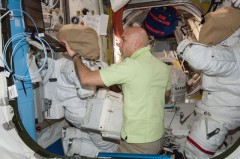
Final preparations for Tuesday’s EVA will commence about five hours before the two men depart the airlock. Cassidy and Parmitano will follow a well-trodden path of “pre-breathing” on masks, during which time extensive communications and other checks will be performed and biomedical data verified. About an hour later, the pressure of Quest’s inner “equipment lock” will steadily be reduced from its normal 14.7 psi down to 10.2 psi, as the astronauts run through the suit-up procedure. When Cassidy and Parmitano are in their suits, the pressure will be returned to 14.7 psi and they will perform a nominal “pre-breathing” period, lasting about 50 minutes, followed by a further 50 minutes of In-Suit Light Exercise (ISLE). This protocol—first debuted on the STS-134 mission in May 2011—will involve the two spacewalkers flexing their knees for four minutes, resting for one minute, and repeating over and over until the 50 minutes have passed. ISLE serves to remove nitrogen from their blood in a much shorter time period.
By about 7 a.m. EDT, an hour before the EVA is due to start, the fully-suited pair will have transferred into Quest’s outer “crew lock” and Mission Control will issue a “Go” to begin depressurization. In the next few minutes, the last pieces of equipment will be passed through from the equipment lock to the crew lock and hatches between the two will be closed. Depressurization of the crew lock should commence at about 7:30 a.m., based on the timelines of previous EVAs. As the pressure slowly drops, a brief pause is scheduled at about 5 psi for standard leak checks, after which the process will resume and should be reduced almost to vacuum for the scheduled EVA start time of 8:10 a.m. The spacewalk, which marks the 22nd station-based EVA from the USOS, will officially begin when Cassidy and Parmitano transfer their suits’ life-support utilities to internal battery power.
Opening the outer hatch of the crew lock, Cassidy will push his helmeted head into the void for the second time on his current mission. He previously led a contingency spacewalk with Expedition 35’s Tom Marshburn, back on 11 May, to identify and resolve an ammonia leak from the P-6 truss. Cassidy also performed three EVAs to install and outfit Japan’s Exposed Facility on the STS-127 mission in July 2009. For Parmitano, it will be his first experience of EVA, and television viewers will glimpse for the first time the red, white, and green stripes of the Italian flag on the arm of a spacewalker. The astronauts’ helmets are also equipped with lights and cameras, to enable terrestrial observers to follow their every move. “This will allow us here at the Columbus Control Centre, near Munich, to ‘see’ through Luca’s eyes,” ESA noted on its blog, “and follow what he is doing during the several hours of his spacewalk. The cameras use wireless video, so we are able to record the entire spacewalk for later view and assessment.”
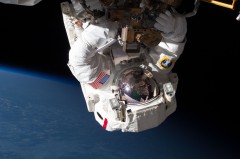
Although several Italians have flown into space—the first being Franco Malerba, back in July 1992—none to date have ever made an EVA. Parmitano’s achievement may soon be matched by the first female Italian spacefarer, Samantha Cristoforetti, who is scheduled for her own six-month ISS expedition, beginning in December 2014. Although it remains to be seen if Cristoforetti will bag a spacewalk of her own, she has undergone extensive training, including work to support the contingency EVA on 11 May.
Upon leaving the airlock, there will be little time for Cassidy and Parmitano to admire their surroundings. Cassidy will carry a replacement Space-to-Ground Transmitter Receiver Controller (SGTRC), part of the Space-to-Ground Antenna (SGANT) hardware which funnels data between the station and Mission Control through NASA’s Tracking and Data Relay Satellite network. There are two SGANTs aboard the ISS, one of which suffered a failure of its SGTRC in December 2012 and was effectively put out of action. This left the station in a “non-fault-tolerant position,” which is highly undesirable because a single failure could cause significant problems. Cassidy will translate to the top of the Z-1 truss, replace the SGTRC, and transfer the failed unit back to the crew lock.
Whilst Cassidy completes his first task, Parmitano will move over to the ExPRESS Logistics Carrier (ELC)-2 on the starboard S-1 truss to begin the retrieval of two scientific experiments: the Materials International Space Station Experiment (MISSE)-8 and the Optical Reflector Materials Experiment (ORMatE). They form the latest in a line of payloads to expose new and affordable materials and computing elements to the ultra-vacuum, unfiltered sunlight, swinging temperature extremes, and harsh atomic oxygen environment of low-Earth orbit. MISSE-8 was launched aboard STS-134 in May 2011, and ORMatE followed aboard STS-135—the final flight of the space shuttle program—in July. They are housed within a suitcase-like Passive Experiment Container (PEC) and are due to be returned to Earth aboard SpaceX’s CRS-3 Dragon cargo ship in December 2013.
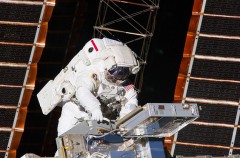
Upon reaching ELC-2, Parmitano will photograph the experiments and remove them for transfer back to Quest. “We will bring these experiments back inside the station,” explained Parmitano in his pre-launch NASA interview, “and then with one of the commercial cargo ships they will come back to Earth, where scientists and engineers will be able to recover those experiments and study them and come back with some results.” The two spacewalkers should arrive back at the airlock about 90 minutes into the EVA.
Their next task—and one which Cassidy expects to consume around half of their 6.5 hours outside—will be the installation of a pair of radiator grapple bars onto the port (P-1) and starboard (S-1) trusses. The bars are properly known as the Heat Rejection Subsystem Grapple Fixtures (HRSGFs) and were delivered to the station aboard SpaceX’s CRS-2 Dragon cargo ship in March. Cassidy and Parmitano will move them from their present home on the Mobile Base System to the outboard trusses. The purpose of the bars is to provide a capability for Canadarm2 to interface with the station’s radiator elements, should the need arise to repair or replace them. The two spacewalkers will disconnect the bars from their Payload Orbital Replacement Unit Accommodation (POA) on the Mobile Base System (MBS) and transfer them to their final P-1 and S-1 locations.
Additionally, the astronauts will retrieve a Mast Camera from the MBS—with Cassidy scheduled to set up a handling fixture (or “scoop”) and Parmitano assigned the task of physically disconnecting and removing the device—and will install a pair of “jumper” cables onto the box-like Z-1 truss. They are also expected to begin laying the groundwork for the arrival of Russia’s Nauka module, whose launch has been delayed from December 2013 and is now unlikely to occur before the spring of next year, by installing power and data cables across the Unity node and Pressurized Mating Adaptor (PMA)-1.
Whilst working, the risk of either Parmitano or Cassidy becoming physically separated from the space station is low, but nevertheless always present, and thus all ISS spacewalkers benefit from the SAFER backpack. This was first tested on STS-64 in September 1994 by astronauts Mark Lee and Carl Meade. Unlike the Manned Maneuvering Unit (MMU)—famously trialed by Bruce McCandless in February 1984—the $7 million SAFER was never intended for satellite repairs, but as a design solution for the shuttle program’s requirement for a means of astronaut “self-rescue.” Its mandate centered on the fact that a tether failure during an EVA would render it immensely difficult to undock the shuttle, rendezvous and retrieve a “lost” spacewalker, and re-dock in a safe manner.
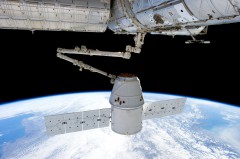
Developed by the Automation and Robotics Division at NASA’s Johnson Space Center in Houston, Texas, SAFER carries 24 fixed-position compressed nitrogen thrusters and is attached to six “hard-points” at the base of the life-sustaining backpacks of Cassidy and Parmitano. Powered by a 28-volt battery pack, SAFER’s attitude-control system includes an automatic attitude-hold and six degrees of freedom. Unlike the MMU, it has no bulky arms for hand controllers, instead being equipped with thruster “towers” extending up the sides of the backpack, and on STS-64 Lee and Meade operated it from controls hard-secured to their suit torsos. (In the current ISS configuration, the SAFER’s controller is embedded within one of the thruster towers and is swung out by the simple pulling of a lanyard.)
Returning to the airlock at the end of their first EVA together, Cassidy and Parmitano can look forward to their second spacewalk on Tuesday, 16 July. On that occasion, the pair will also depart Quest at 8:10 a.m. EDT and spend 6.5 hours outside. USOS EVA-23 will continue the work of its predecessor. According to NASA’s Expedition 36 press kit, the EVA will involve the removal of the grapple bars’ alignment guides, the routing of networking cables for the Nauka module, and the removal of insulation from one of the space station’s Main Bus Switching Units. A number of other activities, including “get-ahead” tasks, are also planned.
Want to keep up-to-date with all things space? Be sure to “Like” AmericaSpace on Facebook and follow us on Twitter:@AmericaSpace




I try to catch as much of the space walks as I can on NASA TV or wherever. Call me a ‘space freak’ or ‘science nerd’, but I get a real kick seeing the ISS in live videos with astronauts ‘outside’. Is there a need or are there any future plans to patch the hole seen in the solar panels? Oh yeah… here come the Perseids!